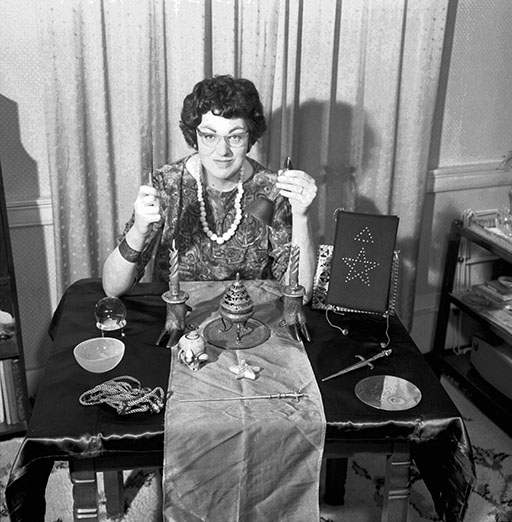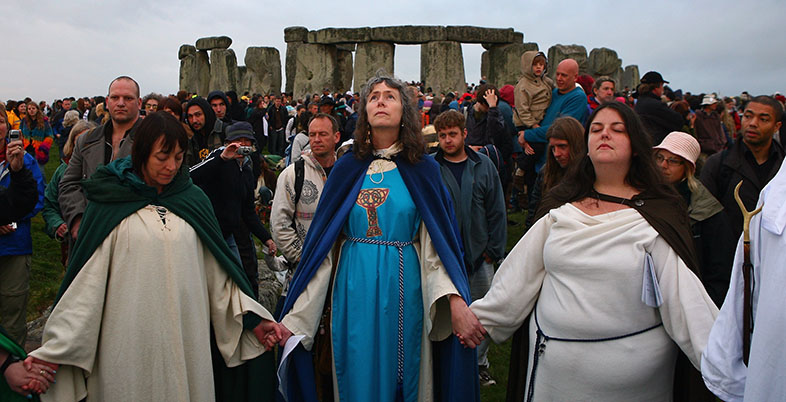3.1 Gardner’s coven
In 1954, three years after the Witchcraft Act was repealed, Gerald Gardner published Witchcraft Today, an account of his earlier initiation by Dorothy Clutterbuck into a coven of witches – part of a Goddess-worshipping religion which had survived in secret since before the Romans brought Christianity to the British Isles. They had decided that it was now time to come out of the shadows, and had chosen Gardner to be their mouthpiece. This was presented in a readable, first-person account as a piece of academic research, and included a foreword by a respected anthropologist, Margaret Murray. Murray was well known for the now-discredited theory presented in The Witch-Cult in Western Europe (1921) that before the arrival of the Romans, Europe’s religion was focused on a fertility Goddess, which men and women worshipped together in magical rituals.
Witchcraft Today was a success, and Gardner soon began to receive letters from prospective new initiates, mostly, though not exclusively, female. His own Bricket Wood coven began to grow, and it wasn’t long before new covens began to appear. Gardner also attracted a good deal of press interest, which he seems to have encouraged.
By the time of Gardner’s death in 1964, Wicca was growing slowly but steadily, with new covens being established. Doreen Valiente, who had been High Priestess of Gardner’s coven, had broken with him to found her own coven in 1957. She developed Gardner’s rituals considerably, most notably adding poetic material including the popular Charge of the Goddess, which encapsulates many of the central beliefs of the Wiccan worldview – and of 1960s seekers more broadly.
Activity 4
Read the poem, The Charge of the Goddess, by Doreen Valiente. How does it reflect the spiritual concerns of the baby boomers? Jot down a few thoughts as you read.
Listen to the words of the Great Mother, who was of old also called Artemis; Astarte; Diana; Melusine; Aphrodite; Cerridwen; Dana; Arianrhod; Isis; Bride; and by many other names.
Whenever ye have need of anything, once in a month, and better it be when the Moon be full, then ye shall assemble in some secret place and adore the spirit of me, who am Queen of all Witcheries.
There shall ye assemble, ye who are fain to learn all sorcery, yet have not yet won its deepest secrets: to these will I teach things that are yet unknown.
And ye shall be free from slavery; and as a sign that ye are really free, ye shall be naked in your rites; and ye shall dance, sing, feast, make music and love, all in my praise.
For mine is the ecstasy of the spirit and mine also is joy on earth; for my Law is Love unto all Beings.
Keep pure your highest ideal; strive ever toward it; let naught stop you or turn you aside.
For mine is the secret door which opens upon the Land of Youth; and mine is the Cup of the Wine of Life, and the Cauldron of Cerridwen, which is the Holy Grail of Immortality.
I am the Gracious Goddess, who gives the gift of joy unto the heart. Upon earth, I give the knowledge of the spirit eternal; and beyond death, I give peace, and freedom, and reunion with those who have gone before. Nor do I demand sacrifice, for behold I am the Mother of All Living, and my love is poured out upon the earth.
Hear ye the words of the Star Goddess, she in the dust of whose feet are the hosts of heaven; whose body encircleth the Universe; I, who am the beauty of the green earth, and the white Moon among the stars, and the mystery of the waters, and the heart’s desire, call unto thy soul. Arise and come unto me.
For I am the Soul of Nature, who giveth life to the universe; from me all things proceed, and unto me must all things return; and before my face, beloved of gods and mortals, thine inmost divine self shall be unfolded in the rapture of infinite joy.
Let my worship be within the heart that rejoiceth, for behold: all acts of love and pleasure are my rituals. And therefore let there be beauty and strength, power and compassion, honour and humility, mirth and reverence within you.
And thou who thinkest to seek for me, know thy seeking and yearning shall avail thee not, unless thou know this mystery: that if that which thou seekest thou findest not within thee, thou wilt never find it without thee.
For behold, I have been with thee from the beginning; and I am that which is attained at the end of desire.

Discussion
At first glance, this poem may seem more concerned with invoking the ancient world than with appealing to modern spiritual sentiments. It is written in a deliberately formal style, and makes frequent use of archaic and perhaps even Biblical language, including ‘thine’, ‘thou’, and ‘seekest’. The substance, however, is certainly largely in line with the expressive individualism and subjective seekership of the baby boomers.
First, there is a clear emphasis on gender equality, something which many women in the 1960s sought, though did not always achieve; the Sacred feminine is invoked throughout in the figure of the Goddess, also identified as the Great Mother, “Queen of all Witcheries” and the names of mother goddesses from a range of ancient mythologies and religions. Her connection to the moon, another well-established symbol of feminine mystery, is also repeatedly made. Through this theology, and the prominence of figures like Valiente, Wicca perhaps came closer to gender equality than most religions in the 1960s.
The Goddess is also ‘the beauty of the green earth’, and the ‘Soul of Nature’, and the sacrality of nature is something that is central to Paganism, and widespread in the New Age milieu. Indeed, the modern environmental movement has some historical connections with the New Age movement.
Finally, the poem invokes a joyful freedom which is implicitly contrasted with the moral strictures of the church: the admonition to ‘dance, sing, feast, make music and love, all in my praise’. The individualistic nature of the baby boomer seeker can be seen in the line ‘thine inmost divine self shall be unfolded’; in other words, the purpose of the devotion is not simply to honour the Goddess, but to do so in order to honour and understand yourself. It even talks explicitly about seeking, and finding what you seek within you.
